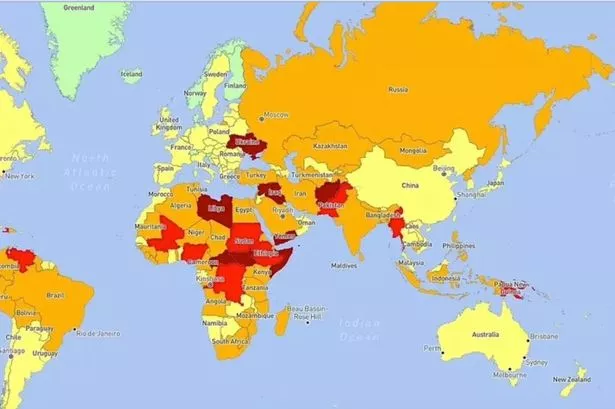Herbalist Dr MziziMkavu
JF-Expert Member
- Feb 3, 2009
- 42,329
- 33,138

The map shows the world's most dangerous countries (Image: travelriskmap.com)
Vacationers have been advised not to travel to the world's most dangerous countries, which are highlighted on an interactive map created by International SOS. These nations are where tourists are most likely to encounter political unrest, crime, and other violence.
Called the Risk Map, the map also lists countries where there are climate change risks. Some countries, such as Ukraine, Libya, Syria, and Iraq, are classified as having an "extreme" security risk. The map, on the other hand, shows the safest nations to visit. These include Greenland, Norway, Finland, Iceland or Luxembourg.
“For the coming year, geopolitical tensions, unrest and political instability are expected to impact business operations. This is reflected in the map with the Sahel, parts of the Middle East and Ukraine in the ‘high’ or ‘extreme’ security risk category," said Sally Llewellyn, Global Security Director, at International SOS.
"International SOS continues to support organizations operating in these locations, including through providing verified information and advice on how such risks will affect their workforce or by supporting evacuations where needed."
Most of Europe, the USA, China and Canada are among the lowest-risk nations. Meanwhile, South Africa, Egypt, Algeria, Kenya, Brazil, Peru, Bolivia, Mexico, the Philippines, Iran, Turkey and Russia are categorized as medium risk.
Conflicts evolve, so some areas have seen their risk ratings change this year. Lebanon, the Palestinian Territories, and Russia have all seen their risk ratings jump. Ecuador and parts of Colombia have also been upgraded on the risk category amid political unrest.
El Salvador and Nepal, meanwhile, have had their ratings downgraded after downward trends across a number of risk factors.
"The propensity for geo-political or socio-economic developments, natural hazards and other threats requires that travellers remain well informed and prepared for short-notice and sometimes high-impact disruptions," said Michael Rogers, Chief Security Analyst, at International SOS.
" Organisations should emphasise the importance of pre-travel risk assessment as well as situational awareness for travelling employees to navigate travel risks effectively.
“It is also crucial for organisations to have clear communication protocols in place for reporting security incidents and ensuring that prompt assistance is readily available when needed. In the event of a significant incident, clear, wide-reaching proactive communication from security management covering the organisation’s response goes a long way toward appeasing anxieties and elucidating the next steps.
"By implementing proactive measures and fostering a culture of risk awareness, employers can empower their workforce to make informed decisions and enjoy a safe and healthy holiday season.”
source.
Irish Star